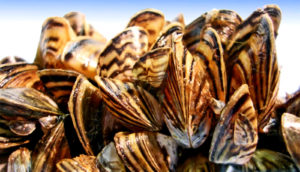Several Fairfield County projects are among the recipients of the inaugural round of grant funding through the Aquatic Invasive Species Grant Program, the Connecticut Department of Energy and Environmental Protection (DEEP) has announced.

A total of $360,000 is going to 21 projects to reduce impacts of aquatic invasive species on inland waters in Connecticut.
The Aquatic Invasive Species Grant Program was created in 2019 when the Connecticut General Assembly established an ”¯Aquatic Invasive Species Stamp”¯ fee applied to all registered boats using Connecticut waters, to provide a dedicated funding source for the”¯ Connecticut Lakes, Rivers and Ponds Preservation Account.
That account funds programs to protect the state”™s lakes, ponds and rivers by addressing aquatic invasive species and cyanobacteria blooms.
Aquatic invasive species such as Zebra mussels and Hydrilla negatively impact native plants and animals, can be extremely costly to control, and ”“ via the dense mats formed by invasive plants ”“ make boating, fishing and swimming difficult.
The issue has a direct impact on both the quality of outdoor recreation in Connecticut and the state”™s outdoor recreation economy, of which boating and fishing are the largest contributors, according to DEEP Deputy Commissioner of Environmental Conservation Mason Trumble.
“These species are costly to counteract,” Trumble said, “but these grants will better enable our recipients to do the critical work of controlling and researching aquatic invasives, which will preserve the quality of our ecosystems and outdoor recreation here in Connecticut.”
The maximum grant award was $50,000. Requests for larger grants (up to $75,000) were considered, but only for exceptional and well-justified proposals. Matching funds were required and had to equal or exceed 25% of the total amount of funding received from DEEP under this grant program. A total of 46 projects filed applications for funding.
One of the grant recipients, the Candlewood Lake Authority will receive more than $26,000 to use for a lake steward program.
The projects receiving funding this round are:
| Organization | Project Location | Project Type/Description | Funding Awarded |
| Amos Lake Association, Inc. | Amos Lake, Preston | Control/Management: Control of Variable Water Milfoil and Lake Management Plan for Amos Lake | $21,504 |
| Ball Pond Advisory Committee | Ball Pond, New Fairfield | Research: Identification and Monitoring of Cyanobacteria in Ball Pond, Using Plankton Tows and Fluorometry | $2,960.11 |
| Bantam Lake Protective Association | Bantam Lake | Bantam Lake sediment analysis in anoxic hypolimnion controlling cyanobacteria blooms due to phosphorus loading during lake stratification | $10,367.14 |
| Candlewood Lake Authority | Candlewood Lake | Education/Outreach: Candlewood Lake Watershed Steward Program to Educate Boaters on Aquatic Invasives Threating Candlewood Lake | $26,711 |
| Connecticut Agricultural Experiment Station | various | Research: Support for the CAES Invasive Aquatic Plant Program | $30,000 |
| Connecticut Agricultural Experiment Station | n/a – educational material | Education/Outreach: Connecticut’s Invasive Aquatic Plant, Clam, and Mussel Identification Guide, 4th Edition | $6,000 |
| Connecticut River Conservancy | Connecticut River | Research: Piloting Management of Hydrilla and creating a Hydrilla Management Plan for the CT River watershed | $28,710 |
| Connecticut River Conservancy | Connecticut River | Control/Management: Coordinate hand removal of water chestnut, trapa natans, in the Connecticut River Watershed | $16,795 |
| Edwin M. Wong, Ph.D., Western Connecticut State University | Beseck Lake, Candlewood Lake, Lake Zoar | Research: Identifying and Quantifying Toxin Genes from Cyanobacteria in CT Waterways | $3,225 |
| Farmington River Watershed Association | Rainbow Reservoir | Research: Investigating cyanobacteria blooms in Rainbow Reservoir (Farmington River) to discover causes and evaluate potential remedies | $46,130 |
| Friends of the Lake | Housatonic River Cove and Mouth of Still River, New Milford | Control/Management: Manual Removal of Tapa Natans, Water Chestnut, from a Housatonic River Cove and the Mouth of the Still River | $4,629 |
| Friends of West Side Pond | West Side Pond | Control/Management: Control of Variable Water Milfoil at West Side Pond | $11,000 |
| Housatonic Valley Association | Lake Kenosia, Danbury | Control/Management: Removal of water chestnut from Lake Kenosia | $25,500 |
| Southbury Training Schools | Lake Stibbs, Southbury | Control/Management: Eradication of Water Chestnut in Lake Stibbs | $4,000 |
| Town of Bolton, Town of Vernon, Friends of Bolton Lakes | Middle and Lower Bolton Lakes | Control/Management: Aquatic Invasive Plant Management in the Bolton Lakes | $24,910.50 |
| Town of Coventry | Coventry Lake | Control/Management: Hydrilla Treatment and Tuber Density Monitoring Research Program for Coventry Lake | $50,000 |
| Town of Guilford | Lake Quonnipaug, Guilford | Control/Management: Invasive aquatic plant surveys and management in Lake Quonnipaug | $13,986.50 |
| Town of Mansfield & Coventry CT | Eagleville Lake, Mansfield and Coventry | Research: Developing a Long-Term Strategy and Educational Campaign for Fanwort Management in Eagleville Lake | $6,940 |
| Town of Middlefield | Beseck Lake | Education/Outreach: Boater Education & Vessel Inspections for AIS at the State Boat Ramp on Beseck Lake | $4,695 |
| Town of Salisbury | East Twin Lake and West Twin Lake, Salisbury | Research: Twin Lakes Rare Plant Study | $7,875 |
| Town of Vernon | Tankerhoosen, Dobsonville, Talcottville, Valley falls, Walker Reservoir East, Papermill Ponds | Control/Management: Vernon Ponds Aquatic Plant Management and Outreach | $14,061.75 |



















